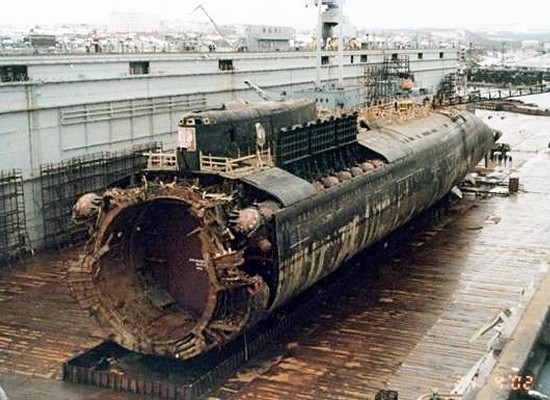Kursk Submarine
K-141 Kursk was an Oscar-II class nuclear cruise missile submarine of the Russian Navy. Launched in 1994, it was commissioned in December of that year. At 154m long and four stories high it was the largest attack submarine ever built.
The Explosion
On the morning of 12 August 2000, as part of a naval exercise, Kursk was to fire two dummy torpedoes at a Kirov-class battle cruiser, Pyotr Velikiy, the flagship of the Northern Fleet. High test peroxide (HTP), a form of highly concentrated hydrogen peroxide used as propellant for the torpedo rocket engine, leaked through bad welds in the tubing into the torpedo and catalytically decomposed on the metals and oxides present there, yielding steam and oxygen. The resulting overpressure ruptured the kerosene tank, resulting in a chemical explosion, causing a weak seismic signature detected hundreds of kilometers away.
According to the maintenance records, the dummy torpedoes, manufactured in 1990s, never had their welds checked; it was considered unnecessary as they did not carry a warhead.
An emergency buoy, designed to release from a submarine automatically when emergency conditions such as rapidly changing pressure or fire are detected and intended to help rescuers locate the stricken vessel, did not deploy. The previous summer, in a Mediterranean mission, fears of the buoy accidentally deploying, and thereby revealing the submarine's position to the U.S. fleet, had led to the buoy being disabled.
Two minutes and fifteen seconds after the initial eruption, a much larger explosion ripped through the submarine. Seismic data from stations across Northern Europe show that the explosion occurred at the same depth as the sea bed, suggesting that the submarine had collided with the sea floor which, combined with rising temperatures due to the initial explosion, had caused other torpedoes to explode.
Twenty-three men working in the sixth through ninth compartments survived the two blasts. They gathered in the ninth compartment, which contained the secondary escape tunnel. Captain-lieutenant Dmitri Kolesnikov wrote down the names of those who were in the ninth compartment. The air pressure in the compartment following the second explosion was still normal surface pressure. It is not known with certainty how long the remaining men survived in the compartment. As the nuclear reactors had automatically shut down, emergency power soon ran out, plunging the crew into complete blackness and falling temperatures. Kolesnikov wrote two further messages, much less tidily than before. In the last, he wrote
"It's dark here to write, but I'll try by feel. It seems like there are no chances, 10-20%. Let's hope that at least someone will read this. Here's the list of personnel from the other sections, who are now in the ninth and will attempt to get out. Regards to everybody, no need to be desperate. Kolesnikov." There has been much debate over how long the sailors might have survived. Water is known to leak into a stationary Oscar-II craft through the propeller shafts, and at 100 metres depth it would have been impossible to plug these. Others point out that the many superoxide chemical cartridges, used to absorb carbon dioxide and chemically release oxygen to enable survival, were found used when the craft was recovered, suggesting that they had survived for several days. Ironically, the cartridges appear to have been the cause of death; a sailor appears to have accidentally brought a cartridge in contact with oily sea water, causing a chemical reaction and a flash fire. The official investigation into the disaster showed that some men appeared to have survived the fire by plunging under the water (the fire marks on the walls indicate the water was at waist level in the lower area at this time). However the fire rapidly used up the remaining oxygen in the air, causing death by asphyxiation.
Initially the other ships in the exercise, all of which had detected an explosion, did not report it. Each only knew about its own part in the exercise, and ostensibly assumed that the explosion was that of a depth charge, and part of the exercise. It was not until the evening that commanders stated that they became concerned that they had heard nothing from Kursk. Later in the evening, after repeated attempts to contact Kursk had failed, a search and rescue operation was launched.
The submarine was found in an upright position, with nose plowed about 2 meters deep into the clay seabed, in depth of 108 meters. The periscope was raised, indicating the accident occurred in a low depth. The nose and the bridge showed signs of damage, the conning tower windows were smashed and two missile tube lids were torn off.
Rescue attempts
The United States offered the use of one of its two Deep Submergence Rescue Vehicles, as did the British government, but all offers were refused by the Russian government. Four days after the accident on 16 August 2000, the Russian government accepted the British and Norwegian governments' assistance and a rescue ship was dispatched from Norway on 17 August and reached the site on 19 August. British and Norwegian deep-sea divers reached the ninth compartment escape hatch on Sunday, 20 August. They were able to determine that the compartment was flooded, and all hope of finding survivors was lost.








